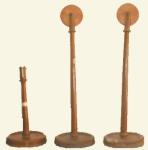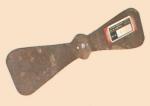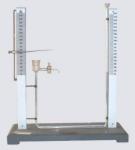

|
Function |

| ||
|
|||
|
Description The apparatus is composed of three poles placed on circular bases. Two poles have a pulley on top while the third is shorter and has a hole for a horizontal pole on its top. It is possible to make experiments on the levers. | |||
 Menu
Menu
 Menu
Menu
|
Function To show that a liquid in a tube without air behaves as a compact mass. |

| ||
| |||
|
Description A glass tube holds water without air. Reversing the tube suddenly we produce a sharp and loud noise. From a similar circumstance we obtain the noises that are heard in central heating radiators at the beginning and during the final phase of the start. | |||
|
Function To study the fall of the bodies. |

| ||
| |||
|
Description It is formed by a glass tube with two brass ring nuts and a tap with threading. Inside the tube we have: a feather, a piece of coloured paper, a wooden sphere and a steel sphere. In vacuum all these objects travel vertically the length of the tube in the same time. The length of the tube is one meter. | |||
 Menu
Menu
|
Function To stabilize the rotation speed of a thermal machine. |

| ||
| |||
|
Description Totally metallic model with a very solid parallelogram, of which two sides hold two brass spheres with the same weight; the other sides drag a cylindrical slider that, controls the access valve of the steam to the cylinders when applied to thermal machines. | |||
|
Function This apparatus is normally called the flattening of the Earth. |

| ||
| |||
|
Description The two rings, fixed to the rotation axe at the bottom assume the form of an ellipse as soon as they are placed in rotation. If we imagine the steel ring divided into parts of equal mass, the centrifugal force is greater for these masses that are farther from the rotation axe. | |||
|
Function To study the effect of the centrifugal force on liquids. |

| ||
| |||
|
Description An escutcheon supports a glass globe. It can be applied to a rotating apparatus. We fill the globe with coloured water. When we reach a certain rotating speed, the water forms a crown leaving the central side empty. | |||
|
Function ? |

| ||
|
|||
|
Description Tin little screw. | |||
|
Function Studying the principle of communicating vessels. |

| ||
|
|||
|
Description A U shaped glass tube is placed on a wooden support. There is a graduated scale. | |||
|
Function Studying the principle of communicating vessels. |

| ||
|
|||
|
Description A U shaped tube filled with mercury is placed on a wooden frame made of a basis and two vertical planks. The left side of the tube is shorter and ends with a goblet from which a horizontal little tube with tap branches off. On the plank two scales are drawn. Besides, an index is placed on a plank . For the experiment we fill the goblet with a liquid different from mercury. | |||
|
Function Transformation of gravitational potential energy in kinetic energy. |

| ||
|
|||
|
Description It is formed by a vertical tube closed at the lower end. Four little tubes placed at 90° and folded at right angle are welded to the lower side. The set is made of a painted metallic plate. The water poured into the tube comes out of the little tubes horizontally and, for the principle of action and reaction, they turn in the opposite direction. The water is collected in a container that also holds the tube. | |||
|
Function Measurement instrument of the density of liquids and solids. |

| ||
|
|||
|
Description It is formed by a metallic tube that ends with two cones. The basket that is used as ballast is conical. In the upper part there is a plane where to put the body of which we want to measure the density. | |||
|
Function To create very low pressures. |

| ||
|
|||
|
Description Pneumatic pump with a hand piston. Made in metal. It is used for low rarefactions. | |||
 Menu
Menu
|
Function Instrument for the measure of the pressure. |

| ||
|
|||
|
Description Under a glass bell we can see the mechanism of a little aneroid barometer. | |||
|
Function It is used to demonstrate the compressibility of gases and the incompressibility of liquids. |

| ||
|
|||
|
Description The apparatus is made of varnished metal. The intermittence is due to the difference of diameter between the efflux hole of the sphere and that formed by the tube. The first lets the water flow only when the second tube is free, that is when the air can come into the top side of the sphere across the right lateral tube. | |||